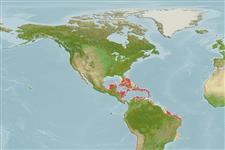Teleostei (teleosts) >
Gobiiformes (Gobies) >
Gobiidae (Gobies) > Gobiinae
Etymology: Bathygobius: Greek, bathys = deep + Latin, gobius = gudgeon (Ref. 45335).
More on author: Ginsburg.
Environment: milieu / climate zone / depth range / distribution range
Ecology
Marine; demersal. Tropical; - 21°S
Western Atlantic: Florida, USA and the Bahamas to the Antilles and Espírito Santo, Brazil (Ref. 40101).
Size / Weight / Age
Maturity: Lm ? range ? - ? cm
Max length : 15.0 cm TL male/unsexed; (Ref. 7251)
Dorsal spines (total): 7; Dorsal soft rays (total): 9; Anal spines: 1; Anal soft rays: 8. This species is distinguished by the following characters: 17-20 pectoral fin rays; 33-36 lateral scale rows; upper jaw length typically 9.2-11.0% SL (one specimen with 11.7%); predorsal squamation reaching anteriorly well beyond vertical through posterior margin of preopercle; first dorsal fin pigmentation variable, typically 1-3 longitudinal stripes with pale distal border of varying width, but sometimes uniformly dusky in larger specimens; trunk with 3 dorsal saddles sometimes reaching lateral midline and row of 6 large square to irregularly shaped blotches beneath lateral midline ranging in size from slightly larger than pupil to as large as or larger than orbit (Ref. 85559).
Inhabits rocky tide pools and along water's edge, but mostly on unsheltered shores.
Life cycle and mating behavior
Maturity | Reproduction | Spawning | Eggs | Fecundity | Larvae
Robins, C.R. and G.C. Ray, 1986. A field guide to Atlantic coast fishes of North America. Houghton Mifflin Company, Boston, U.S.A. 354 p. (Ref. 7251)
IUCN Red List Status (Ref. 130435: Version 2024-1)
Threat to humans
Harmless
Human uses
Tools
Special reports
Download XML
Internet sources
Estimates based on models
Preferred temperature (Ref.
123201): 26.4 - 28.2, mean 27.5 °C (based on 573 cells).
Phylogenetic diversity index (Ref.
82804): PD
50 = 0.5000 [Uniqueness, from 0.5 = low to 2.0 = high].
Bayesian length-weight: a=0.00759 (0.00418 - 0.01376), b=3.07 (2.91 - 3.23), in cm total length, based on LWR estimates for this species & (Sub)family-body (Ref.
93245).
Trophic level (Ref.
69278): 3.6 ±0.6 se; based on size and trophs of closest relatives
Resilience (Ref.
120179): High, minimum population doubling time less than 15 months (Preliminary K or Fecundity.).
Fishing Vulnerability (Ref.
59153): Low vulnerability (10 of 100).
